Seven Reasons Why Aquaman Is No Joke
As the big-budget Aquaman film opens in the U.S. on Friday, December 21, a certain segment of the population continues to ask with disbelief, “Wait, Aquaman gets a movie?” This sentiment is based on years of jokes and pop culture punchlines associated with a character many people have dismissed as “the guy who talks to fish.” But if you take a deep dive into the history of this DC Comics mainstay, who was created in 1941 by Mort Weisinger and Paul Norris, you’ll find that he has a much more complicated background than that. Here are seven reasons why Aquaman is no joke.
1. He’s Royalty
Batman comes from crime, and Superman comes from science fiction, but Wonder Woman comes from mythology, and so does Aquaman. Like the Amazon princess, Aquaman is royalty. Known as Orin in his kingdom of Atlantis and Arthur Curry on the surface, Aquaman is the son of a human lighthouse keeper and an Atlantean princess. The combination makes him a meta-human, possessed of Atlantean abilities like aquatic telepathy (the talking-to-fish bit), enhanced strength, and remarkable swimming abilities. In Atlantis, though he is occasionally deposed through various plot twists and machinations, he’s recognized as a rightful heir to the throne and as a just king.
2. He’s Co-founded the Justice League
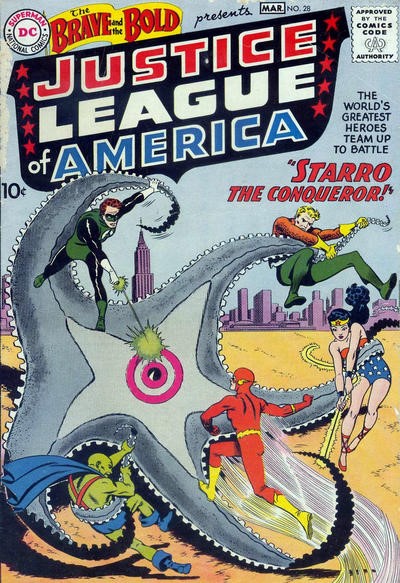
In The Brave and The Bold #28, Aquaman becomes one of the founding members of the Justice League of America, a new and modern take on the 1940s Justice Society. Aquaman’s teammates include Batman, Superman, Wonder Woman, The Flash (Barry Allen), Green Lantern (Hal Jordan), and the Martian Manhunter. Aquaman has been a vital part of the JLA throughout its history, and even serves as its leader for a period in the 1980s.
3. He Was the First Major Superhero to Get Married
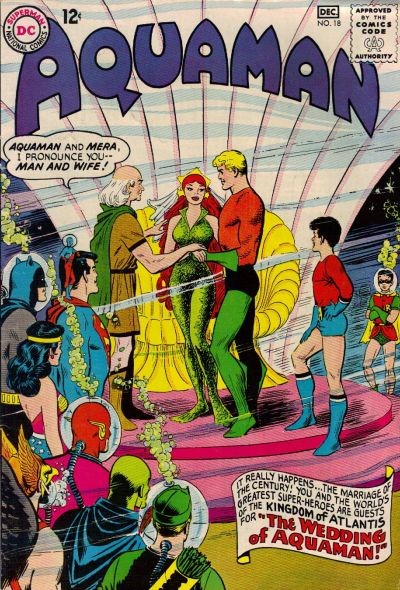
Mera debuted in September 1963, appearing for the first time in Aquaman #11. A queen from another dimension, Mera recruits Aquaman and his sidekick, Aqualad, to win back her throne. Mera later leaves her kingdom to join Aquaman. The couple marries in Aquaman #18 (1964) as Aquaman ascends to the throne of Atlantis. In tying the knot, Aquaman became the first major superhero to wed in his own book without it being a gimmick or imaginary story (something that was particularly common in Superman books of the time).
4. He Was the First Superhero to Become a Parent (and to Lose a Child)
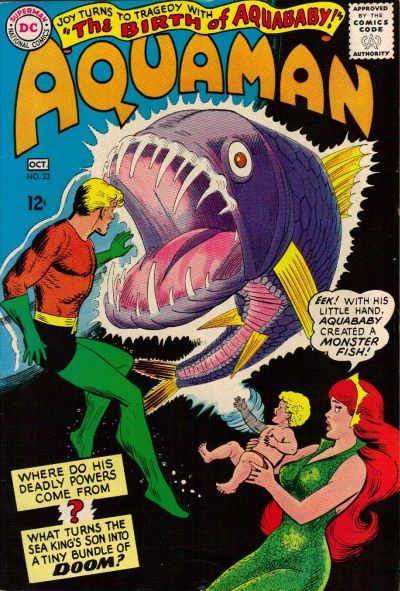
Aquaman and Mera waste no time starting a family. In 1965’s issue #23, Mera gives birth to Arthur Jr., making Aquaman and Mera the first major superheroes to welcome a proper legacy character who isn’t just a sidekick. Arthur Jr. (nicknamed Aquababy) preceded the first appearance of famous superhero progeny Franklin Richards (son of Marvel’s Mr. Fantastic and the Invisible Woman) by three years.
Sadly, Arthur Jr. becomes a pawn in the ongoing war between Aquaman and his nemesis, Black Manta. In Adventure Comics #452, Arthur Jr. suffocates and dies in a trap laid by Black Manta. Issue #60 of Aquaman depicts the devastating aftermath: Mera returns from a journey to her home dimension for a device that could save her son and is informed that he has already died. The gravity of the situation underscores the seriousness that settled into comic storylines during that decade, which would continue into the “grim and gritty ’80s.”
5. He’s New to Movies, but Had a Long Life in Television
Aquaman became a television fixture beginning in 1967. That’s when the character made his animated debut in The Superman/Aquaman Hour of Adventure on CBS. The show, while certainly directed at kids, is fairly faithful to the comics, and includes Mera, Aqualad, and a number of their animal companions, like Tusky the walrus. The following year, Aquaman was spun off into its own 30-minute timeslot on Saturday mornings, partially repackaging segments from the original show.
The opening sequence for every season of Super Friends.
In 1973, Aquaman was chosen as one of the five leads of Super Friends, alongside Superman, Wonder Woman, Batman, and Robin. The series proved to be a major Saturday-morning hit that ran in various iterations until 1986. Aquaman was present in every season, but it’s here that the “I’ll check the coasts” cliché surrounding his effectiveness came into being. Though he occasionally presents the solution to problems or provides critical assistance, Aquaman frequently plays in the background to the Big Three. He was well represented in merchandising of the time, receiving action figures in various lines from Mego and Kenner, and appearing on lunchboxes and, yes, Underoos.
Attacking Aquaman with water is a poor plan. From Justice League Unlimited.
After the modern DC Animated Universe kicked off in the 1990s, Aquaman shows up for the first time in an episode of Superman: The Animated Series. Unfortunately, Aquaman wasn’t a founder of the Justice League in the subsequent Justice League and Justice League Unlimited series, but he did appear a number of times as an ally. Here, the character has the long hair and beard from his ’90s comic look (we’ll get to that in a minute). Aquaman is also referenced in the future-set Batman Beyond, as his daughter is a member of the future Justice League.
Aquaman wants out of his family vacation on Batman: The Brave and The Bold.
An extremely popular take on the character appeared regularly in the more humorous Batman: The Brave and the Bold series of 2008-2011. Voiced by John DiMaggio (the comedian also known for voicing Bender on Futurama and Jake on Adventure Time), Aquaman is depicted as a swaggering, memoir-writing braggart of the Errol Flynn variety while simultaneously being utterly romantic about the concept of heroism. His frequent cry of “Outrageous!” became a fan catch-phrase, and an episode devoted to a family RV trip that Mera forces him to take with her and Arthur Jr. was a series highlight. Since then, Aquaman has popped up in both serious and comedic series like Young Justice (serious) and Teen Titans Go! (not so much).
Aquaman, Mera, and Green Arrow appear in the “Patriot” episode of the 10th season of Smallville.
On the live-action side, model and singer Alan Ritchson played Aquaman in four episodes of Smallville between 2005 and 2010. A spin-off pilot called Mercy Reef was shot with actor Justin Hartley in the role, but it wasn’t picked up. However, the CW liked Hartley enough to cast him as Green Arrow in Smallville, and he and Ritchson would appear together as the two heroes before the series concluded.
The final trailer for the Aquaman film.
Today, of course, Aquaman swims on the big screen. The new Aquaman film will be actor Jason Momoa’s third outing as the Sea King, after a cameo in Batman v Superman: Dawn of Justice in 2016 and full participation in Justice League in 2017. The Hawaiian-born Momoa is no stranger to the water, having worked at a surf shop before landing the role of lifeguard Jason Ioane for 38 episodes of Baywatch. He’s also used to heroic team-ups: He played high school soccer alongside Brandon Routh (Superman of Superman Returns and The Atom on The CW’s Legends of Tomorrow).
6. He Replaced His Severed Hand with a Harpoon
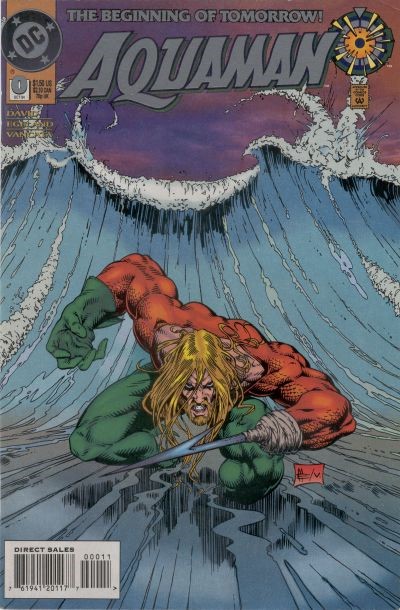
This is where we clarify the long hair thing. Yes, Aquaman had short hair for the first 50 years or so of his fictional existence. In a brand-new series launched in 1994, partially due to the modernization of comics and partially due to the general excellence of writer Peter David, Aquaman sports a more Poseidon-esque long-hair-and-beard combination. In the second issue, Aquaman loses his hand battling the villain Charybdis and replaces it with a harpoon. The new look and now hardened attitude brought new reader interest, and David repaid it with a strong run of stories featuring some long-neglected ocean-related characters like Dolphin, Neptune Perkins, and Tsunami, as well as new characters Deep Blue and Koryak.
Soon after, when the JLA was rebooted under writer Grant Morrison, it was this version of Aquaman that Morrison used. Morrison built on David’s foundation, coming up with new power stunts for the Sea King (like using his aquatic telepathy to incapacitate humans by affecting the basal ganglia in their brains) and incorporating his rough attitude into well-characterized team dynamics. Both the David and Morrison runs are considered highlights of 1990s superhero comics.
7. He’s Way More Powerful Than You Think
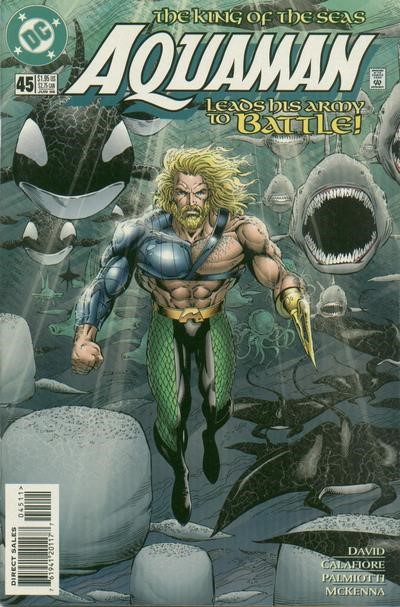
Look at it this way: Aquaman patrols the seas, and therefore has to protect more than 71 percent of the planet. He’s the King of Atlantis, so he has to deal with all of the problems of rule. Then again, he has a massive army at his back, and the sea life of the Earth is his to command. His Atlantean physiognomy makes him super-humanly strong, with the endurance to go with it. It’s hard to hurt him because his body can withstand the pressures of the deep. He swims faster than a speedboat and can breathe underwater. On land, he loses none of his overall toughness, and he’s learned to modify his aquatic telepathy for attack. Though he’s not as skilled at it as Mera, he’s also shown that he can perform feats of hydrokinesis — the telekinetic shaping and control of water into weapons. He frequently uses tridents in serious battle, some of which have additional powers bestowed upon them. His best friends are the most powerful superheroes in the universe, and alongside them he’s fought homicidal villains, alien invaders, and extradimensional demons. In no way, shape, or form is Aquaman just “the guy who talks to fish.”
So if you’d been wondering why Aquaman gets a movie, maybe it’s time to actually consider this: What took Hollywood so long?